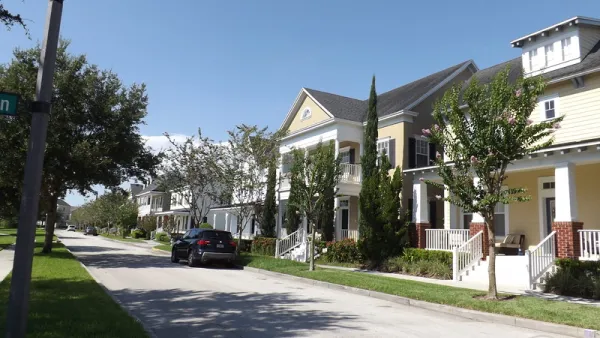Instead of always fighting to make sprawl development harder, let's focus our energy on making great infill development easier.
It seems fitting to start a new blog with a sweeping declaration so here’s one to shout from the rooftops: sprawl is bad. By contrast, infill is good. And despite the recession, the two development types constantly compete for our housing dollars. Consider your own decisions. You, as a planner, have faced the choice of where to purchase a home. In your own personal way, you have debated the trade-offs of living in a bedroom community versus the heart of the city. How often have you chosen to live in the city? Or rather, how often do you get a choice?
Whatever the answer, it usually comes down to the availability and affordability of quality infill. If it’s there and we can afford it, we naturally select it. We’re planners, after all. But the opportunity is rare in most communities.
Indeed, there’s nothing more tragic than the fact that many of us who help build great communities can’t afford to live there. And as housing demand (and the pressure of sprawl) begins to mature this summer, we may lose a powerful opportunity to gain ground on this issue.
Over the years, the communities I’ve served have tried everything to curb sprawl. They’ve taken cues from case studies, applied tactics from toolkits, and earned scars from plans gone sour. Every proposal has tested the limits of a community’s will to change.
In every project, we’ve tried fighting sprawl by adding more demanding regulation. TDRs, TODs, and UGBs. Overlays, density caps, impact fees, and more.
Few solutions have been effective. In fact, the only thing to truly stop sprawl was the recession.
So here’s a different approach: as housing markets return, let’s ignore sprawl policies for a while and focus on infill policy instead. And let’s address infill in a completely new way.
If you accept the fact that sprawl and infill compete for the same consumer, what if we tilted the fight? What if we gave great infill development a real competitive advantage? Specifically, what if we removed barriers for great infill instead of making new barriers for sprawl? Economically, if great infill were easier to develop than sprawl, there would be more of it in many cities.
Bear in mind that the idea isn’t to make any infill easy--only great infill. And what is great infill? Anything that fits your city’s plan. This is the vital part of the equation: a city must have a clear definition of great (infill) development expressed in a visual manner. This seems obvious but it often goes overlooked.
The next step is where we can really change course: from the plan (i.e., the visual definition of ideal development), we define the absolute least amount of rules necessary to make the ideal possible. Whatever that is, we write it into law and dispose the rest. We make a lean, strategic, purpose-driven policy.
Take my city, Columbia, Tennessee, as an example. Here, we recently defined great infill in each basic context (suburban, urban, etc.), grabbed a blank sheet of paper, and wrote an entirely new development policy [PDF]. This clean slate helped us discover what policies were irrelevant or, worse, detrimental to the cause. It also helped us understand why we had so much more sprawl than originally intended. Our old books weren’t based on a vision. There was no lucid picture of great development. There were just generic rules applied unilaterally. So infill and sprawl were treated the same. Same basic zoning categories, same use restrictions, same parking requirements, same review processes.
This equal treatment is a disaster. History shows that when sprawl and infill are treated the same (i.e., same rules, same process), sprawl wins. It costs less and faces less uncertainty in the public review.
Indeed, the uncertainty of public review processes has been especially harmful to infill efforts. By nature, infill development affects more neighbors and thus more people attend meetings and voice concerns. All the while, a new subdivision on the edge of a greenfield garners little attention. Fewer live next to it and, thus, fewer are aware or concerned.
So again, when we visually defined great development in our city and wrote our policies around the ideal, we learned what mattered most: the scale of buildings, their placement relative to the street, and some basic architectural elements were crucial. But land uses? Those were secondary. Density? Completely irrelevant. And parking? Parking minimums were often one of the biggest limitations to people reusing old buildings. So we got rid of them where we could.
We found what mattered most, codified those values, and got rid of the rest. No more lot requirements, no more density, no more parking minimums. No more arbitrary conventions written for the purpose of being “comprehensive”. We decided to be cohesive instead. Our new set of rules provides a powerful incentive for infill. If someone meets the small set of vital requirements, they will create great infill development by default and the city can approve the project immediately. This is a boon for the entire community.
This is also where the approach differs from other coding efforts. We know about Miami, Denver, and Cincinnati. Each replaced their codes with something new and fantastic. But what works for these major metropolitans cannot work in the smaller edge cities that experience the more direct pressure of sprawl.
To conclude, I’m a public sector planner so it feels strange to write this but here goes: getting rid of regulations has been a liberating experience. Knowing what we want has allowed us to ask for less. For this reason, we’re now encouraging infill not by adding incentives but by removing arbitrary requirements.
And sprawl? There’s no special treatment there; nothing has changed on that side of our policy. We still heap a great deal of public review on edge developments and scrutinize the impact to our services and character. There’s the same amount of uncertainty and same costs as before. The difference is that it’s now harder to do edge development since infill is made easier. Is it a perfect approach? No, but it’s a better paradigm. It changes the game and accomplishes a core edict that a friend of mine has always advised: make it easy to do the right thing.

Analysis: Cybertruck Fatality Rate Far Exceeds That of Ford Pinto
The Tesla Cybertruck was recalled seven times last year.

National Parks Layoffs Will Cause Communities to Lose Billions
Thousands of essential park workers were laid off this week, just before the busy spring break season.

Retro-silient?: America’s First “Eco-burb,” The Woodlands Turns 50
A master-planned community north of Houston offers lessons on green infrastructure and resilient design, but falls short of its founder’s lofty affordability and walkability goals.

Test News Post 1
This is a summary

Analysis: Cybertruck Fatality Rate Far Exceeds That of Ford Pinto
The Tesla Cybertruck was recalled seven times last year.

Test News Headline 46
Test for the image on the front page.
Urban Design for Planners 1: Software Tools
This six-course series explores essential urban design concepts using open source software and equips planners with the tools they need to participate fully in the urban design process.
Planning for Universal Design
Learn the tools for implementing Universal Design in planning regulations.
EMC Planning Group, Inc.
Planetizen
Planetizen
Mpact (formerly Rail~Volution)
Great Falls Development Authority, Inc.
HUDs Office of Policy Development and Research
NYU Wagner Graduate School of Public Service




























